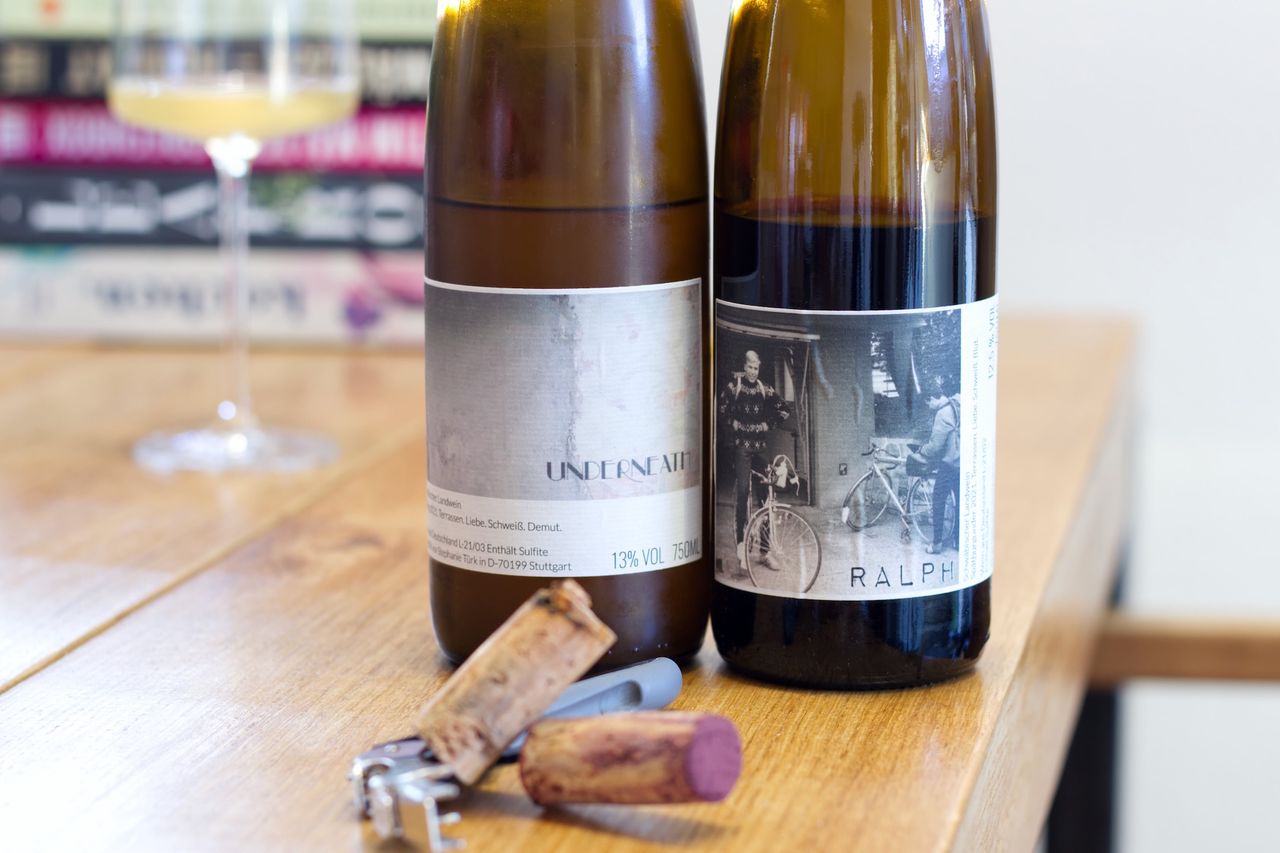Two Bottles Heslach Heights
We are drinking a bottle of Underneath Riesling and a bottle of Ralph Pinot Noir, both from 2021, by Stephanie Türk, who produces tiny amounts of wine under the name Heslach Heights in Stuttgart.

In the southern part of the state capital, remarkable wines are being produced, as we have known since last year.. At Schimmelhüttenweg, between Stuttgart-Süd, Heslach, and Degerloch, Stephanie Türk also started making wine on a quarter hectare. In 2016, she decided to quit her job in Hamburg to produce wine in the south. This was followed by an apprenticeship in winemaking, and in 2021, her first vintage was released. Additional vineyards in Hedelfingen and Untertürkheim have since been added to her portfolio. It’s almost three-quarters of a hectare in total, so still practically nothing. Yet, for a one-woman operation on the outskirts of the city without winery buildings, this is quite significant. And as always with such projects, it means a lot, a whole lot of manual labor. The grapes are naturally handpicked, pressed in an old basket press, and then aged in stainless steel tanks. Four wines were produced in the first vintage: a Trollinger, a Rosé, and the Riesling Underneath and the Pinot Noir Ralph, which stand before us today. “Terraces, Love, Sweat, and Humility” is written on the Riesling label, with only 120 liters available. Again, practically nothing. As for the Pinot Noir, I don’t know the quantity, but it won’t differ much.
We have a rough start, the Riesling and us. The cork already looks rather crumbly from the outside, but decides to leave the bottle in one piece. Yet, it doesn’t look reassuring at all in its entirety. Fortunately, the wine is doing well. It’s very natural. It spent a night on the skins, and you can of course sense that. It’s quite wild, with a lot of grapefruit, lemonade somewhere between Bitter Lemon and Ginger Ale, apple peels, and tea. Very natural, but also very Natural Riesling. The bitterness puckers the tongue, intense, but in such a fruity way that we don’t mind. However, I can imagine it might be different for others. There’s acidity, tension, and juiciness. What began as a tasting glass quickly turns into half a bottle, so we force ourselves to take a fridge break to see what happens the next day.
It gets even wilder and less easy to drink. That touch of lemonade, which contributed to the wine disappearing from the glass faster than we could refill it, is gone. It’s a different wine on the second evening. That’s not necessarily bad, but if you enjoy drinking it as lemony and chuggable as right after opening, then it’s at least a pity. It becomes more tonic, somewhat leaner, more metallic, and more lemon than grapefruit. More the memory of lemon, though, than actual lemon. There’s hops and freshness. Distantly, the Riesling reminds me of a light IPA, with the tannin integrated but stronger, it is a different wine now. Not worse, not better, just different. And because I find that quite exciting, I would actually be interested in trying it again in two to three years. However, I have no more left, and there’s still a fractured cork trust relationship between us anyway.
The Pinot cork is better, but I wouldn’t trust it for several years either. The red streaks have already moved too far up the sides. Whether this affects the entire batch or if we just had a bit of bad luck, I can’t say, of course. And even with the Pinot, it didn’t harm the wine, and maybe, with a bit of optimism, they’ll hold out longer than one might think. The better half smells a downstairs smoky pub with a hint of cherry. For me, it wanders somewhere between earthy red beetroot and sour cherries. And somewhere in the cherry juice, a piece of smoked meat marinates. A bit of wood, a bit of dirt. I really like how it feels though. How it starts muffled on the tip of the tongue, then gradually morphs into fresher sour cherry as it moves towards the back. How it somehow has a lot of tannin in the middle of the tongue and simultaneously cleanses the outside with acidity. It’s somewhat edgy, rustic, perhaps a bit too much at first glance, but actually warm and soft. A bit like us Swabians maybe. Tomorrow, there will be lentils with smoked meat. That will probably be nice together.
In contrast to the Riesling, almost nothing happens to the wine overnight. That’s reassuring because, as hoped, the combination with the lentils is quite magnificent. It’s dirty, structured, acidic, with some fruit passing by. I would never guess it’s Pinot Noir, never ever. But that doesn’t bother me for a second. Lentils, at least how we make them here in Swabia, are the best food on this planet anyway. And if the wine works so well with them, what can I complain about? There are people who say that lentils are just unidentifiable brown mush. But these people are idiots. Sure, only the carrot remains an orange carrot; even the celery loses its color and submits to the dish. But that doesn’t matter. Because lentils, spaetzle, and wiener sausage are something special. It’s identity-affirming food. It’s what one means when saying that something is much more than the sum of its individual parts. It warms you up. And makes you cozy. And this wine, it just makes it all a little bit better. And that says much more about the wine than I could.